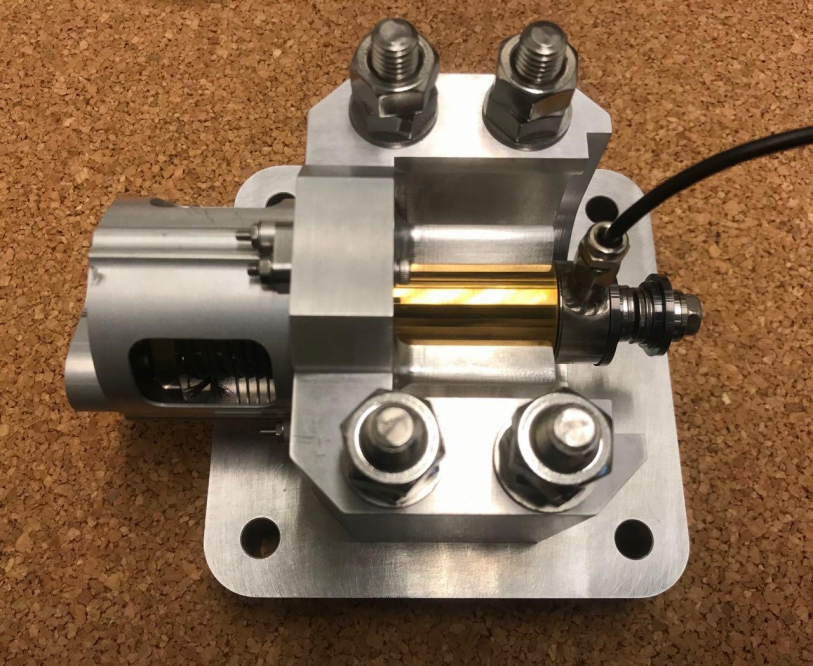
-
StatusCompleted
-
Status date2019-06-14
-
Activity Code4E.043
The project aims to develop, build and test a fully-reusable non-explosive actuator for hold-down and release mechanism, with a preload capacity of 10 kN. The Engineering Model has been built with representative materials and processes, and tested in representative conditions, corresponding to TRL5.
The project focused both on the release actuator and preload assembly, providing a generic actuator design that can be implemented for different platforms and applications.

The scope of activities for the RUNE mechanism is performed under a joint EM/QM approach. The mechanism is developed as a qualification model (QM) up to CDR, while the production, assembly and testing are carried on an engineering model (EM).
Four critical parameters for the development of the mechanism are identified:
Reliability, self-generated release shock, reusability and release time (repeatability and simultaneity). These parameters guide the development of RUNE. From the start of the project, three features are identified as highly desirable: ultra-low self-generated shock and reusability.
Also of concern during the development process was the need to avoid any pre-existing intellectual property rights. A large number of existing patents in the field has been analysed in order to steer the development process away from previously patented concepts, and ensure patentability of the present concept. This adds additional constraints on the design space to an ambitious fast-acting ultra-low-shock reusable design.
RUNE is a fast-acting, fully re-usable, ultra-low shock HDRM, enabling a discrete point separation.
Self-generated release shock
HDRM are characterized with respect to their self-generated Shock Response Spectrum (SRS) peak: RUNE releases Ultra-Low Shock (<40g SRS) during its operation.
Re-usability & Resettability
Assembly, Integration and test (AIT) procedures require multiple HDRM releases, and are greatly simplified when re-usable HDRM are employed. The re-usability of an HDRM is thus a key feature with respect to its implementation in space systems. RUNE is fully reusable (i.e., resettable); Furthermore, its operation requires access from only one side of the mechanism (the HDPA bolt side, the same side used to torque the HDPA bolt).
Release Time (Repeatability & Simultaneity)
Time-critical releases and multi point simultaneous releases require reliable and repeatable releases, with minimal scattering (dispersion) of individual release times, even for HDRMs at different temperature. RUNE is a fast-acting mechanism with low actuation time scatter.
RUNE releases Ultra-Low Shock during its operation:
- The Shock Response Spectrum (SRS) peaks are below 50g for axial, horizontal and vertical directions, during a 10 kN preload release.
RUNE is easy to use:
- The mechanism is fully reusable (i.e., resettable). The mechanism reset operation is performed by one operator in less than a minute.
RUNE is a fast-acting mechanism with low actuation time scatter:
- The initiation time is between 10 ms and 60 ms (depending on initiation current and the extremes of the operational temperature range: +85 ºC / -50 ºC)
- The total actuation time is between 55 ms and 180 ms (depending on initiation current and the extremes of the operational temperature range: +85 ºC / -50 ºC)
- At ambient conditions the mechanism’s total actuation time is on average 105 ms, with a maximum measured scatter of 17 ms.
RUNE uses standard pyrotechnic electric signals (26V-40V, 4.1A 30ms pulse nominal). Its dimensions are approximately 42mm diameter per 40mm height, and it weighs 208g.
The RUNE mechanism is a discrete point separation device of generic type, i.e. independent from any specific application. Its design is scalable in order to widen as much as possible the range of potential applications and preloads.
RUNE’s functionality is provided by five basic elements:
|
Force Magnitude |
Elements |
Description |
|
Initiator |
Converts electrical energy from the release actuation pulse into mechanical energy usable by the latch elements. |
|
|
Latch |
Maintains the HDRA in the secured configuration; up to reception of the release actuation signal by the Initiator. |
|
|
Force |
Effective force reduction elements are crucial for reliable synchronous ultra-low shock HDRA designs. These provide the necessary leverage and load-uncoupling, between the high forces present at the hold-down preload assembly (HDPA) and the coupling elements, down to the low-energy initiator at the latch. |
|
|
Preload |
Mechanical elements that reduce the HDPA preload immediately before releasing the HDPA bolt member. This feature is not effective in all existing HDRA, but RUNE includes it in its design in order to reduce the self-generated shock during release. |
|
|
Coupling |
Mechanical elements that interface and secure the HDPA bolt, or an adaptor on the HDPA. |
The force reduction elements form the backbone of RUNE, and are based in Euler (capstan) friction provided by a cable which wraps around a cylindrical body while constraining the coupling elements. In conjunction with the used coupling elements, this provides the required load uncoupling and provides a very effective preload relief function.
The high force reduction achieved enables the use of low mass and volume SMA initiator, while maintaining the electrical requirements of existing pyro lines (current, voltage and pulse times).
All the planned milestones of the project are completed: Preliminary design review (PDR), detailed design review (DDR), test readiness review (TRR) and the post-test review (PTR).
The scope of activities for the RUNE mechanism is performed under a joint EM/QM approach. The mechanism is developed as a qualification model (QM) up to DDR, while the production, assembly and testing are carried on an engineering model (EM).
As part of the activity’s initially planned tasks, an implementation plan is defined, laying forth the future activities required for the completion of:
- Successful qualification testing of a QM.
- Development up to a commercially available product and the delivery of a FM
A QM/EM RUNE mechanism has been designed, manufactured and tested in representative conditions. The mechanism is developed as a qualification model (QM) up to DDR, and the production, assembly and testing are carried on an engineering model (EM).
The mechanism was designed, produced and assembled, and performed successfully in all the planned tests.



